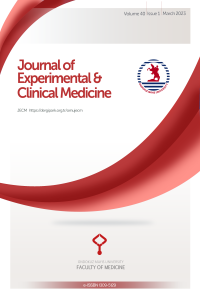Case Report
Year 2023,
Volume: 40 Issue: 1, 186 - 187, 18.03.2023
Abstract
References
- Jouffroy R, Vivien B. Time to Return of Spontaneous Circulation (ROSC) and Survival: Tissue and Brain Perfusion Is Probably More Important than ROSC. Prehosp Emerg Care. 2021 Oct 4:1-2.
- Rosow C, Manberg PJ. Bispectral index monitoring. Anesthesiol Clin North Am. 2001 Dec;19(4):947-66, xi.
- Avidan MS, Zhang L, Burnside BA, et al. Anesthesia awareness and the bispectral index. N Engl J Med. 2008 Mar 13;358(11):1097-108.
- Kim TY, Hwang SO, Jung WJ, et al. Early neuro-prognostication with the Patient State Index and suppression ratio in post-cardiac arrest patients. J Crit Care. 2021 Oct;65:149-155.
- Welsby IJ, Ryan JM, Booth JV, et al. The bispectral index in the diagnosis of perioperative stroke: a case report and discussion. Anesth Analg. 2003;96:435-7.
- Morimoto Y, Monden Y, Ohtake K, et al. The detection of cerebral hypoperfusion with bispectral index monitoring during general anesthesia. Anesth Analg. 2005;100:161.
- Özdemir S, Cimilli T, Onur ÖE. Relationship between the National Institutes Health Stroke Scale Score and Bispectral Index in Patients with Acute Ischemic Stroke. J Exp Clin Med. 2021; 38(4): 440-444.
- Kusken O, Ozturk TC, Hunuk A, et al. Relationship between brain computed tomography findings and bispectral index score in patients presenting with head trauma. North Clin Istanb. 2019; 6:219–25
- Trzeciak S, Jones AE, Kilgannon JH, et al. Significance of arterial hypotension after resuscitation from cardiac arrest. Crit Care Med. 2009;37(11):2895–2903
- Lee BK, Jeung KW, Lee HY, et al. Association between mean arterial blood gas tension and outcome in cardiac arrest patients treated with therapeutic hypothermia. Am J Emerg Med. 2014;32(1):55–60.
Year 2023,
Volume: 40 Issue: 1, 186 - 187, 18.03.2023
Abstract
The bispectral index is electroencephalography-based technology is used to monitor sedation. BIS is a processed EEG parameter, that was designed specifically to assess patient responses to sedation and anesthesia. In this case report, we aimed to discuss the bispectral index changes during resuscitation of a patient who presented with cardiopulmonary arrest in the light of the literature.
References
- Jouffroy R, Vivien B. Time to Return of Spontaneous Circulation (ROSC) and Survival: Tissue and Brain Perfusion Is Probably More Important than ROSC. Prehosp Emerg Care. 2021 Oct 4:1-2.
- Rosow C, Manberg PJ. Bispectral index monitoring. Anesthesiol Clin North Am. 2001 Dec;19(4):947-66, xi.
- Avidan MS, Zhang L, Burnside BA, et al. Anesthesia awareness and the bispectral index. N Engl J Med. 2008 Mar 13;358(11):1097-108.
- Kim TY, Hwang SO, Jung WJ, et al. Early neuro-prognostication with the Patient State Index and suppression ratio in post-cardiac arrest patients. J Crit Care. 2021 Oct;65:149-155.
- Welsby IJ, Ryan JM, Booth JV, et al. The bispectral index in the diagnosis of perioperative stroke: a case report and discussion. Anesth Analg. 2003;96:435-7.
- Morimoto Y, Monden Y, Ohtake K, et al. The detection of cerebral hypoperfusion with bispectral index monitoring during general anesthesia. Anesth Analg. 2005;100:161.
- Özdemir S, Cimilli T, Onur ÖE. Relationship between the National Institutes Health Stroke Scale Score and Bispectral Index in Patients with Acute Ischemic Stroke. J Exp Clin Med. 2021; 38(4): 440-444.
- Kusken O, Ozturk TC, Hunuk A, et al. Relationship between brain computed tomography findings and bispectral index score in patients presenting with head trauma. North Clin Istanb. 2019; 6:219–25
- Trzeciak S, Jones AE, Kilgannon JH, et al. Significance of arterial hypotension after resuscitation from cardiac arrest. Crit Care Med. 2009;37(11):2895–2903
- Lee BK, Jeung KW, Lee HY, et al. Association between mean arterial blood gas tension and outcome in cardiac arrest patients treated with therapeutic hypothermia. Am J Emerg Med. 2014;32(1):55–60.
There are 10 citations in total.
Details
| Primary Language | English |
|---|---|
| Subjects | Health Care Administration |
| Journal Section | Case Report |
| Authors | |
| Early Pub Date | March 18, 2023 |
| Publication Date | March 18, 2023 |
| Submission Date | February 6, 2022 |
| Acceptance Date | July 1, 2022 |
| Published in Issue | Year 2023 Volume: 40 Issue: 1 |
Cite

This work is licensed under a Creative Commons Attribution-NonCommercial 4.0 International License.


